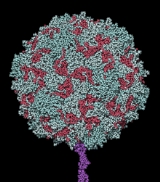
CD155
Encyclopedia
CD155 also known as the poliovirus receptor is a protein
that in humans is encoded by the PVR gene
.
in the immunoglobulin superfamily. Commonly known as Poliovirus Receptor (PVR) due to its involvement in the cellular poliovirus
infection in primates, CD155's normal cellular function is in the establishment of intercellular adherens junction
s between epithelial cells. The role of CD155 in the immune system
is unclear, though it may be involved in intestinal humoral immune responses
.
The external domain mediates cell attachment to the extracellular matrix
molecule vitronectin
, while its intracellular domain interacts with the dynein
light chain Tctex-1/DYNLT1
. The gene is specific to the primate lineage, and serves as a cellular receptor for poliovirus in the first step of poliovirus replication.
, D1-D3, where D1 is recognized by the virus.
Low resolution structures of CD155 complexed with poliovirus have been obtained using electron microscopy
while a high resolution structures of the ectodomain
D1 and D2 of CD155 were solved by x-ray crystallography.
Protein
Proteins are biochemical compounds consisting of one or more polypeptides typically folded into a globular or fibrous form, facilitating a biological function. A polypeptide is a single linear polymer chain of amino acids bonded together by peptide bonds between the carboxyl and amino groups of...
that in humans is encoded by the PVR gene
Gene
A gene is a molecular unit of heredity of a living organism. It is a name given to some stretches of DNA and RNA that code for a type of protein or for an RNA chain that has a function in the organism. Living beings depend on genes, as they specify all proteins and functional RNA chains...
.
Function
CD155 is a Type I transmembrane glycoproteinGlycoprotein
Glycoproteins are proteins that contain oligosaccharide chains covalently attached to polypeptide side-chains. The carbohydrate is attached to the protein in a cotranslational or posttranslational modification. This process is known as glycosylation. In proteins that have segments extending...
in the immunoglobulin superfamily. Commonly known as Poliovirus Receptor (PVR) due to its involvement in the cellular poliovirus
Poliovirus
Poliovirus, the causative agent of poliomyelitis, is a human enterovirus and member of the family of Picornaviridae.Poliovirus is composed of an RNA genome and a protein capsid. The genome is a single-stranded positive-sense RNA genome that is about 7500 nucleotides long. The viral particle is...
infection in primates, CD155's normal cellular function is in the establishment of intercellular adherens junction
Adherens junction
Adherens junctions are protein complexes that occur at cell–cell junctions in epithelial tissues, usually more basal than tight junctions...
s between epithelial cells. The role of CD155 in the immune system
Immune system
An immune system is a system of biological structures and processes within an organism that protects against disease by identifying and killing pathogens and tumor cells. It detects a wide variety of agents, from viruses to parasitic worms, and needs to distinguish them from the organism's own...
is unclear, though it may be involved in intestinal humoral immune responses
Humoral immunity
The Humoral Immune Response is the aspect of immunity that is mediated by secreted antibodies produced in the cells of the B lymphocyte lineage . B Cells transform into plasma cells which secrete antibodies...
.
The external domain mediates cell attachment to the extracellular matrix
Extracellular matrix
In biology, the extracellular matrix is the extracellular part of animal tissue that usually provides structural support to the animal cells in addition to performing various other important functions. The extracellular matrix is the defining feature of connective tissue in animals.Extracellular...
molecule vitronectin
Vitronectin
Vitronectin also known as VTN is a protein that in humans is encoded by the VTN gene.The protein encoded by this gene is a member of the pexin family...
, while its intracellular domain interacts with the dynein
Dynein
Dynein is a motor protein in cells which converts the chemical energy contained in ATP into the mechanical energy of movement. Dynein transports various cellular cargo by "walking" along cytoskeletal microtubules towards the minus-end of the microtubule, which is usually oriented towards the cell...
light chain Tctex-1/DYNLT1
DYNLT1
Dynein light chain Tctex-type 1 is a protein that in humans is encoded by the DYNLT1 gene.-Further reading:...
. The gene is specific to the primate lineage, and serves as a cellular receptor for poliovirus in the first step of poliovirus replication.
Structure
CD155 is a transmembrane protein with 3 extracellular immunoglobulin-like domainsImmunoglobulin domain
The immunoglobulin domain is a type of protein domain that consists of a 2-layer sandwich of between 7 and 9 antiparallel β-strands arranged in two β-sheets with a Greek key topology....
, D1-D3, where D1 is recognized by the virus.
Low resolution structures of CD155 complexed with poliovirus have been obtained using electron microscopy
Electron microscope
An electron microscope is a type of microscope that uses a beam of electrons to illuminate the specimen and produce a magnified image. Electron microscopes have a greater resolving power than a light-powered optical microscope, because electrons have wavelengths about 100,000 times shorter than...
while a high resolution structures of the ectodomain
Ectodomain
An ectodomain is the domain of a membrane protein that extends into the extracellular space . Ectodomains are usually the part of a protein that initiate contact with surface which leads to signal transduction. In SARS-CoV the ectodomain of the spike protein is responsible for attachment to and...
D1 and D2 of CD155 were solved by x-ray crystallography.

